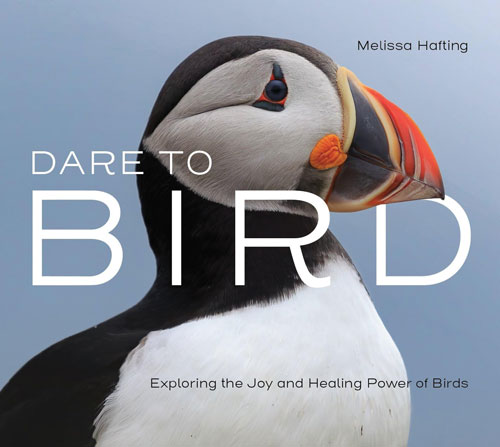Dare to Bird: Exploring the Joy and Healing Power of Birds, the debut book by BC-based author Melissa Hafting, defies categorization and complicates reader expectations. What at first appears to be a coffee table book of Hafting’s photographs, Dare to Bird reveals itself as something altogether more engaged and profound.
Hafting opens with an epigraph from respected wildlife biologist, author and poet J. Drew Lanham: “I want people to look at birds and admire them, adore them. But then I want them to take their binoculars down and look around and understand why things are as they are. And then ask what they’ve done to either make things better or make them worse.” These words from an established Black conservationist who has himself experienced both the awe of the more-than-human world and the prejudice of the human world serve to underline the approach Hafting takes to this unique collection.
I opened this book fully prepared to appreciate the phenomenal photography throughout and to expand my understanding of the birds of western North America; what I hadn’t anticipated was the profound respect I quickly developed for Hafting’s bravery, both on the page and in the world. Dare to Bird is unique in its blending of photography and social commentary, its pairing of activism and memoir and its framing through the eyes of a mixed-race BIPOC woman.
Hafting grounds her book in community, from the diverse and inclusive groups of young birders she takes out to experience their first sightings, to the monitoring projects she has established in her home community of Richmond, BC, to the extensive human impact on the survival rates of various bird species. At its core, this book acknowledges human action as responsible for the devastation of bird populations, while also nodding to the resilience of birds and the potential of coming human generations to choose to act in the world with greater awareness.
Dare to Bird caught me by surprise with its blend of science, racial and political awareness, environmental realism and vulnerable narrative. Hafting weaves lived experience with scientific knowledge, touching on the necessity of increased diversity in the birding world and safety for BIPOC people wishing to engage in pastimes such as birding that have been profoundly non-diverse.
But Hafting has a second focus in her book, too: the ability of the more-than-human world to offer solace in times of intense grief and loss. In Hafting’s case, the loss was of her parents, dead within a few months of each other. The sudden absence of the very people who supported her in her early fascination with nature threatens to destabilize her. To regain her balance, Hafting turns to birding and its attendant communities for healing.
Drawing together environmental caution, science, social commentary and devastating personal narrative, along with an infectious enthusiasm for birds and truly exquisite photographs, Dare to Bird is a fascinating book.
Jenna Butler is an author and scholar near Barrhead. Her most recent book is Revery: A Year of Bees (Wolsak & Wynn).
____________________________________________
Read more from the archive “Wings of Change” October 2024.


